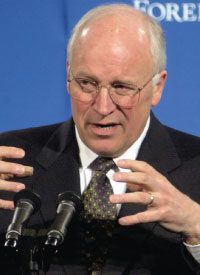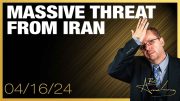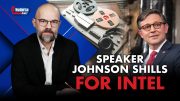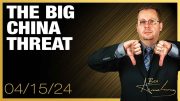
It was the kind of company in which Cheney could feel spiritually and intellectually at home, among men of great power, influence, and intellect, men who know exactly how the world should be run and are confident God would agree with them if He only knew the facts of the matter. Cheney was no doubt aware the event was being televised nationally on C-Span, but he chose, nonetheless, to boast of an aspect of his career that he had carefully kept out of the spotlight, both in his national campaign as Republican nominee for Vice President and in his six winning campaigns to represent the people of his state in the U.S. House of Representatives.
“And it’s good to be back at the Council on Foreign Relations,” Cheney said, after thanking the group for a warm welcome. “I’ve been a member for a long time, and was actually a director for some period of time.” He added, with a widening grin, “I never mentioned that when I was campaigning for reelection back home in Wyoming.” He paused long enough to accommodate the appreciative laughter, then added, “but it stood me in good stead.”
Strident (Albeit Quiet) Strides
Indeed, few people have ever parlayed their personal and political connections to climb up the political ladder further or faster than Richard B. Cheney. And he still seldom mentions his ties to the other architects of a “new world order” in the Council on Foreign Relations. The CFR is nowhere mentioned in his controversial 565-page memoir In My Time that has recently brought him back to the talk-show circuit on his book tour. In fact, he has been in the limelight as much or more since leaving office than when he was Vice President. Since early in 2009, Cheney has been making speeches, appearing on talk shows, lambasting Obama, and generally casting his large and imposing shadow over American foreign policy in an effort to keep it moving in the same orbit in which he steered it under the aegis of President George W. Bush. And so far, the effort appears successful.
Conservatives may be glad that Cheney was able to steer Bush, the self-proclaimed “decider guy,” away from his campaign promise to battle “global warming” by reducing emissions of carbon dioxide and other pollutants in what journalist and Pulitzer Prize- winning author Barton Gelman called “a case study in management of an errant boss.” (The President announced the issue required more study.) They may wish the “veep” had similarly dissuaded his “errant boss” from pursuing other goals, including “education reform” (the No Child Left Behind Act) and expanding the budget-busting blessings of Lyndon Johnson’s Great Society (prescription drug benefits under Medicare). But those issues were not the big blips on the Vice President’s radar screen, if they were on there at all. If Cheney was, in fact, the “small-government conservative” that some believed he was on domestic issues, he was very much a “big-stick” Republican in foreign affairs. His impact on and, to a large extent, direction of foreign policy during the Bush presidency suggests that if he was and is a conservative, his is the kind of conservatism George Will described as believing that “government can’t run Amtrak, but it can run the Middle East.” And he was remarkably effective at keeping those who questioned one aspect or another of his view “out of the loop” when decisions were made.
One important decision that had to be made early on in the post-9/11 “war on terrorism” and the invasion of Afghanistan had to do with the treatment of captured enemy combatants and terrorist suspects. Cheney had David Addington, counsel to the Vice President, type up a four-page executive order that denied foreign terrorist suspects access to any court. They would be tried, if at all, by military commissions. Years later Congress would pass legislation establishing trials by military commissions, but in the fall of 2001, there was no such statute on the books. Addington was relying on the precedent set by President Roosevelt in World War II, when he set up military commissions to try Nazi saboteurs. But, Gelman noted, in relying on the FDR decision and the 1942 Supreme Court ruling upholding it, Addington had to overlook laws passed and treaties made over six subsequent decades. When Bush paused long enough to sign the document before boarding a plane for a trip to Crawford, the Cabinet members who had not been told about it, Gelman said, included Secretary of State Colin Powell and National Security Advisor Condoleezza Rice. When Powell heard about it on CNN, he picked up the phone and asked, “What the hell happened?”
The Management
Cheney acquired a lot of nicknames during his eight years as Vice President, including “Darth Vader,” after the primary villain in the movie Star Wars, and “Dark Side” after the evil force in the same movie. Another was “Management,” as in “Better check with management first.” To suggest that Cheney was the managing partner of the Bush-Cheney administration is no exaggeration. People seem to affirm it even while trying to deny it. Bradford Berenson, White House counsel in Bush’s first term described the President as “guiding the ship of state from high up on the mast. It seemed to me that the Vice President was more willing to get down in the wheel house below the decks.” Since the wheelhouse is where the pilot is, one might wonder how much guiding Bush was doing from “high up on the mast.”
Former Sen. Phil Gramm (R-Texas) described the free hand Cheney appeared to have in his dealings with Congress. “Dick could make a deal,” Gramm told Gelman, author of Angler: The Cheney Vice Presidency. “He didn’t have to check with the president, not as far as I could tell. I’m sure at the end of the day, he would fill the president in on what happened. But Dick had the agency of the president.”
The Secret Service came up with “Angler” as Cheney’s code name, an apparent reference to his love of fishing. But it also describes well one who pursued every angle to increase his already considerable power. Consider, for example, the way Cheney conducted the search for a vice presidential candidate. As we all know, Cheney’s search ended with the choice of Cheney to be Bush’s running mate. It is also common knowledge that Bush asked his father’s former Defense Secretary twice to be his running mate and twice Cheney declined. But his refusals were far from unequivocal Shermanesque statements of non-candidacy. (“I will not accept if nominated and will not serve if elected,” William Tecumseh Sherman said in 1884 when considered as the Republican candidate for President.) By both his account and Bush’s in their respective memoirs, Cheney offered a number of reasons why he might be a liability for Bush: his two DUI convictions in his youth (Bush had one of his own), his heart problems, and the fact that they were both Texas oilmen. (The Constitution prohibits electors from voting for candidates for both President and Vice President who reside in the same state.) Bush found none of them disqualifying. The residency issue was quickly resolved when Cheney made a quick trip to register as a voter back home in Wyoming. But that came after he had vetted several other candidates for the job — and what a vetting it was, as Gelman described in his book.
Cheney required each prospective running mate to fill out a questionnaire nearly 200 questions long, including queries about everything from mental illness to marital infidelity to bad debt. Medical records, including clinical notes and lab results, were required, along with details of any visit to a psychiatrist, psychologist, therapist, or counselor. Cheney and his selection committee wanted to know of any professional sanctions or allegations of malpractice and even about “misconduct in school.” Details of the lives and records of spouses, children, and in-laws were likewise required. To guard against any omission, the candidate was required to certify that “Richard B. Cheney” was authorized to receive any financial or other confidential records pertaining to the candidate. Finally, the candidate was asked to specify in writing anything that might leave him “vulnerable to blackmail or coercion.”
So if a potential vice presidential candidate had any flaws, any vulnerabilities, any skeletons at all in his or her closet, Cheney would likely know about them and be able to report them to Bush. Or he could file them away for his own future use, as Oklahoma Governor Frank Keating ruefully discovered. Keating, who filled out the detailed questionnaire and provided a small mountain of documents to go with it, included one detail that Cheney later found useful. Some years earlier, a friend who was a wealthy philanthropist offered to pay for the college education of Keating’s three children. Keating reasoned that there was nothing the gentleman was seeking in return, and in Keating’s job at the time in the Department of Housing and Urban Development, he had nothing he could have offered him, anyway. He sought a ruling from HUD’s ethics staff and found the lawyers had no objection, as long as he declared the gifts on his annual disclosure forms and recused himself from any government business affecting the benefactor. The general counsel of the Office of Government Ethics offered the same judgment. Keating reported the payments every year during the time he was a federal employee. And in what he later described as an “abundance of caution,” he included an account of those gifts in the information he rendered to Cheney and his selection team.
Becoming Mr. Vice President
When it turned out Cheney himself would be the vice presidential nominee, a reporter playfully asked Keating if he had thought about applying for the job Cheney would be vacating as president of Halliburton. No, Keating replied, but added that he might like to head up the search committee. It was a clever quip, but “Management” was not amused. Not long after, Keating got a call from a reporter who inquired about the wealthy friend and campaign contributor who had paid for his kids’ education. The story of the gifts, totaling roughly $250,000 became a political nightmare for Keating and the subject of an investigation by the Oklahoma legislature. To put an end to it, Keating decided to pay back the money. But the damage to his reputation had been done, and he could think of only one source for the story — Dick Cheney or someone on the staff of the man who was then Vice President-elect.
Years later, Cheney would himself joke about his role in the selection of Bush’s vice presidential candidate. “My close association with the President goes back to the year 2000, when he asked me to lead the search for a vice presidential nominee,” he remarked to a friendly audience in 2008. “That worked out pretty well,” he observed.
Cheney had by that time maintained a “close association” with men of power and influence for more than 40 years, starting with his employment on the staff of a young Congressman from Illinois named Don Rumsfeld. His personal and professional friendship with former Defense Secretary Don Rumsfeld goes back to the first term of the Nixon administration, when Rumsfeld was head of, and Cheney worked for, the Great Society creation known as the Office of Economic Opportunity — one of those big-government agencies that small-government conservatives dislike, but are happy to occupy whenever Republicans have the White House. Later Rumsfeld headed up, and Cheney served on, Nixon’s Cost of Living Council. Following Nixon’s resignation in the Watergate scandal, both men filled high-level vacancies in the new Ford administration, with Rumsfeld taking over as Secretary of Defense and Cheney, at 34, becoming the President’s Chief of Staff. Cheney’s contributions to the short-lived presidency of Gerald R. Ford included his role in persuading the new President to choose New York Governor Nelson Rockefeller as his Vice President, and then dump him for Bob Dole when Ford ran for election.
Following Ford’s loss to Jimmy Carter in the 1976 election, Cheney returned to Wyoming and two years later won the first of his six elections as Wyoming’s lone member of the U.S. House of Representatives. During his time in the legislative branch, Cheney fought for what he saw as the prerogatives of the executive. He authored the minority report of the committee that investigated the Iran-Contra affair, essentially defending President Reagan’s role in diverting money from the sale of arms to Iran to the rebels fighting the Sandinista government in Nicaragua, despite an act of Congress banning funding of the Contras. As Secretary of Defense under the first President Bush, Cheney was a principal architect of Bush’s war to establish a “new world order” by forming a coalition of nations to liberate Kuwait from Iraqi occupation. His zeal for increasing executive power at the expense of the constitutional authority of the Congress grew as the battle plans were formed.
“I loved the Congress,” Cheney recalls in his memoir, In My Time. “I had served there for ten years.” He just didn’t think Congress could be trusted to decide something as important as whether or not the country should go to war. Cheney argued against asking for authorization of the military force to drive Iraq out of Kuwait. “We had all the authority we needed,” he wrote, “because the United States Senate had previously ratified the United Nations Charter, including Article 51, which allowed us to go to the assistance of a member state, such as Kuwait, that had been invaded.” Besides, Congress might actually exercise its power to say no, despite all the best laid war plans and troop deployments by the men in the White House and the Pentagon. “Moreover if we got turned down by the Congress, it would be a huge blow to our coalition and to our troops already deployed.” Finally, success covers a multitude of usurpations. “If the military action was successful, it wouldn’t matter whether Congress supported us beforehand.”
Sallying Against Saddam
Cheney lost that argument — sort of. President George H.W. Bush asked for and got the authorization from Congress. But he later acknowledged that he would have gone forward with Operation Desert Storm even if the votes had gone against him. And in his losing campaign for reelection, the elder Bush demonstrated how much respect he had for both the Congress and the Constitution when he claimed: “I didn’t have to get permission from some old goat in Congress to kick Saddam Hussein out of Kuwait.”
Kuwait was liberated early in 1991 and in April of that year, Cheney offered the following assessment of why the United States and its coalition partners did not force “regime change” in Iraq at that time:
If you’re going to go in and try to topple Saddam Hussein, you have to go to Baghdad. Once you’ve got Baghdad, it’s not clear what you do with it. It’s not clear what kind of government you would put in place of the one that’s currently there now. Is it going to be a Shia regime, a Sunni regime or a Kurdish regime? Or one that tilts toward the Baathists, or one that tilts toward the Islamic fundamentalists? How much credibility is that government going to have if it’s set up by the United States military when it’s there? How long does the United States military have to stay to protect the people that sign on for that government, and what happens to it once we leave?
That, of course, describes almost to a “t” the dilemma that has followed since the taking of Baghdad 12 years later in an invasion that Bush, Cheney, and others in the administration insisted was necessary to protect America against another terrorist attack. “Everything changed after 9/11” was the common refrain. Or had it? In Cheney’s final year as Secretary of Defense, his Pentagon produced a strategic plan that the CBS Evening News described as a blueprint for a “new world order.” In asserting the United States would brook no rival power challenging its dominant role in the world “or seeking to overturn the established political and economic order,” the document anticipated in many ways the “Bush doctrine” of a decade later, in which the second President Bush claimed a right to launch a preventive war against any nation perceived as a potential military threat to the United States. That was the doctrine that led America and allied nations into Iraq to remove those mysterious “weapons of mass destruction.”
Was Cheney lying when he stated categorically that Saddam Hussein was developing such weapons? Or was he just massaging the truth a lot? In the months leading up to the March 2003 war, there was plenty of reason to doubt the administration line. There was, for example, a report from the Defense Intelligence Agency that “there is no reliable information on whether Iraq is producing and stockpiling chemical weapons or whether Iraq has [established] or will establish its chemical warfare agent production facilities.” A National Intelligence Estimate, compiled by the nation’s intelligence agencies, cited “little speci?c information” about chemical weapons in Iraq and expressed “low confidence” that Saddam Hussein “would engage in clandestine attacks against the U.S. Homeland,” and “low confidence” that he would “share chemical or biological weapons with al-Qa’ida.” Hussein’s alleged quest for yellowcake uranium, cited by Bush in his 2003 State of the Union Address as evidence of his determination to build nuclear weapons, was “highly dubious,” according to the State Department’s Bureau of Intelligence and Research. Machine parts cited as evidence of a nuclear weapons program were “poorly suited” for nuclear use, according to the U.S. Department of Energy.
Since leaving office with an approval rating in the teens, Cheney became an increasingly visible and vocal defender of the policies of the late, unlamented Bush-Cheney administration, including the “enhanced interrogation” of prisoners by methods known in simpler times as torture. The man who worked mostly in the shadows and seldom gave interviews while Vice President became a frequent guest on talk shows, claiming President Obama was endangering the nation’s security by calling for an end to those interrogation techniques and promising to close the detention facility for captured Afghan terrorist suspects at Guantanamo Bay. “The man who never talked is now the man who won’t shut up,” complained New York Times columnist Maureen Dowd. “Cheney has popped out of his dungeon, scary organ music blaring, to carry on his campaign of fear and loathing,” she wrote in a description that might well have appealed to the man called “Dark Side.”
“Am I the evil genius in the corner that nobody ever sees come out of his hole?” Cheney asked at the midpoint of his vice presidency. “It’s a nice way to operate actually.”
Photo of Dick Cheney at the CFR: AP Images



